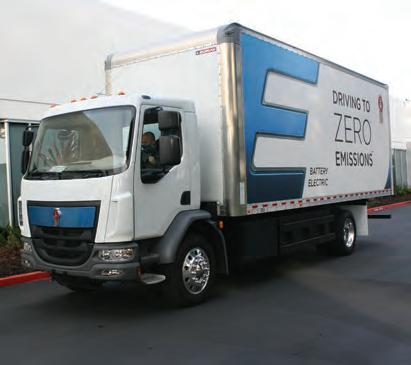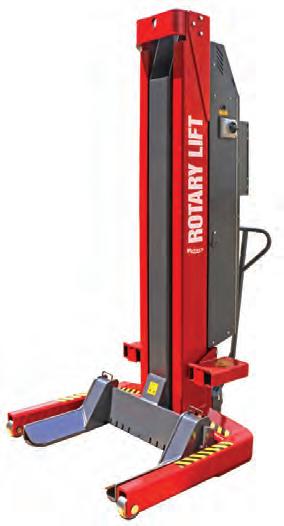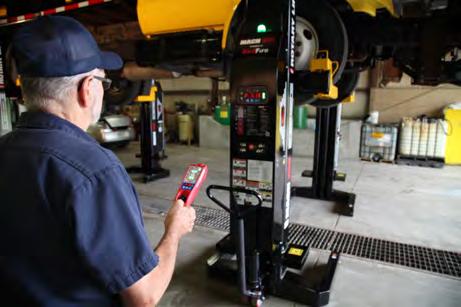
6 minute read
ELECTRIC KENWORTHS UNVEILED
In the USA, PowerTorque’s US Correspondent, Steve Sturgess, was on hand to learn about Paccar’s zero emission plans for the future and to see a selection of electric Kenworths unveiled.
Kenworth in the US recently staged a show’n’tell of its electric vehicle lineup. Appropriately, it was in California’s Silicon Valley where the Paccar Innovation Center is located, close to advanced research centres of all kinds and academia to be able to share advanced developments and test them for the appropriateness for medium and heavy truck innovation.
On hand for the short, urban drives were the class 6 K270E, the class 8 T680E and one of the prototype fuel-cell T680s currently under development with Toyota.
THE TRUCKS The truck that held the most interest for me was the fuel-cell electric (FCEV). It is powered by hydrogen which reacts with oxygen from the air in the cell and its main emission is pure water. The involvement of Toyota is from the fact that the FCEV uses two fuel cells from the Toyota Mirai passenger car. A car which is available in California, where public hydrogen fuel stations are scattered around making the fuel reasonably available and the car reasonably practical.
In the T680 FC these fuel cells generate electric power which drive a mid-mount four-speed transmission with the rest of the drivetrain including a conventional driveshaft and tandem drive axle. Depending on application and topography, the range between hydrogen refills is around 350 miles (560km). However, the time it takes to fill the tanks, located in a cupboard behind the cab, is comparable with a diesel truck.
The K270E class 6 and K370E class 7 are medium-duty cabovers that are very European in character. The electric versions have a centre mount E-motor and conventional driveshaft and single axle. The batteries for the all-battery drive system are mounted outside of the frame rails and are available in 141 and 282 kWh packages which give the trucks 100 miles (160km) or 200 mile (320km) range, depending on application. However, it is most likely these trucks will be used in last-mile distribution or on, for instance, beverage applications where routes are thoroughly understood.
Recharging is by braking regeneration on the road and by slow AC charging which takes up to 10 hours. Fast charging by DC can be completed in a little over and hour.
The two mediums are available for order, and delivery times are, in the order of, three months. However, according to Hank Johnson, Kenworth General Sales Manager, at the EV presentation at the Innovation Centre, getting the electric infrastructure in place can take up to a year.
The T680E is also available to order and is a full class 8 day-cab or rigid truck with a range of around 150 miles (240km). Its intended role is as a container hauler. It is also battery-only powered with a 396 kWh pack and an additional 2,000pound (907kg) allowance for the heavier powertrain/batteries so it has a gross vehicle weight rating of 82,000 pounds (37.2 tonnes). With fast charging, it can be recharged in around three hours.
The T680E has a different chassis layout that uses Meritor’s 14Xe electric drive axle, a 14X base axle with a motor and gears on the nose of each differential. Thus there is no mechanical connection to the electronic controller and the drive is all electric until it reaches the single or tandem axle.
Uniquely, Paccar is offering charging solutions through PaccarParts. Additional consulting services can be utilised to realise some of the many zero-emissions incentives and to help in the charging solution most appropriate to the operation looking to go electric.
ON THE ROAD As mentioned, I was keen to drive the Fuel Cell EV so I jumped at this unit first.
Once settled behind the wheel, you fire it up by turning the conventional looking key in its regular position, switch it on and then go to the start position briefly. The truck goes through its diagnostics checks and then gives a dash green light to show it is ready to go. The dash on this truck, incidentally, has a dedicated display for the fuel cell bits and pieces.
Then as with other Paccar automatics, you simply select drive on the steering column stalk, release the brakes and squeeze down on the accelerator.
And that brought a big surprise as this admittedly prototype vehicle was aggravatingly noisy, not the experience I was expecting from an electric drive truck. In the lowest of the four gears there was an

incredible whine caused by the pumps and fans associated with the fuel cell and three separate cooling systems.
In the next gear, this was considerably less intrusive but to a large extent still there. The short road loop was not enough road to get up into higher gears, but the Toyota development drivers seem to be pleased with the experience and are confident that this will be addressed by the time the truck goes into series production.
The performance was as expected, though, with great step off from standstill, and lots of torque for mid-range acceleration. Except for the noise, it was a pleasant driving experience.
By comparison, the battery powered T680E was a magic carpet drive. It was eerily quiet and exhibited the outstanding performance we expect from an electric drive: great step-off acceleration and the ability to run up to its top speed of 65 mph in short order. The most we could get to on the short loop was 45, but it felt very comfortable there. As with diesel T680s, the fit and finish of the cab could be appreciated and the generally tight, rattlefree environment could be enjoyed with the almost silent running gear.
The regenerative braking was a big plus in the driving experience as there was little need to use the service brakes except for a final stop at the several stop signs on the loop. So while a container truck will work in a largely urban environment, there should be no increase in brake servicing, maybe a decrease.
Last, but certainly not least, was the K270E. This cute cabover is very easy to drive with diesel power, but as a battery EV its just a dream. It’s super quiet, turns as you’d expect a European truck and goes way better than the dieselpowered model.
It also features regen braking that in its maximum setting really throws you against the seatbelt.
In the right application, drivers will flock to the K270E and it could well help driver retention. Because it is very nimble with exceptional visibility, it should also prove safe, with lower accident frequencies.
SUMMARY The battery electric Kenworths are a real triumph of technology laid on top of proven architectures. The big question is how much will they cost? That’s where the Kenworth consultants can help. If the total cost of ownership can approach that of a diesel at the end of the day, these zero emissions IKONPCARD-FRONT1.pdf 3 12/05/2021 2:51:16 PM IKON-card-FRONT.pdf 1 12/05/2021 3:24:48 PM trucks are definitely worth consideration for the right applications.
On hand for the short, urban drives was the class 6 Kenworth K270E.
IKON

Lifting solutions for heavy industries...
// IKONLIFTING.COM.AU




ROTARY LIFT
WIRELESS MOBILE COLUMN LIFTS
IKON LIFTING EQUIPMENT PTY LTD
6.2 / 7.5 / 8.5*STOCKED RANGE AVAILABLE: Tonne Capacities 8.5T FLEX-MAX Features:
- All steel control cabinet - Simple display for safe easy operation - LockLight™ load saftey system - Cordless remote control - Spring loaded steering / braking system - Hard rubber covered steel wheels - Digital gauges shows vehicle height and weight - Robust network connectivity
| Nationwide 24/7 service support ..
(03) 9088 6278
sales@ikonlifting.com.au









